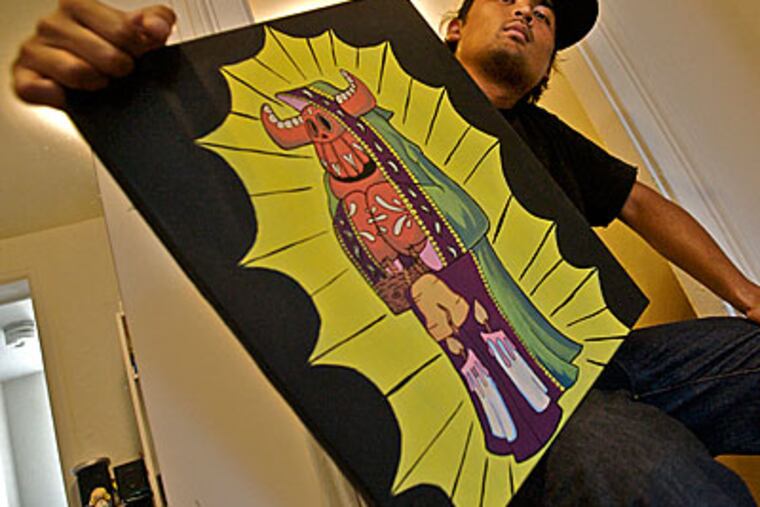Monica Yant Kinney: Artist quits graffiti, but police still skulk
Justin Nagtalon made mistakes. But he swears he saw the light after getting caught leaving his mark on the world illegally in 2007.

Justin Nagtalon made mistakes. But he swears he saw the light after getting caught leaving his mark on the world illegally in 2007.
"I did graffiti. I stopped. I realized, 'I'm 25. This is juvenile,' " recalled Nagtalon, a Philadelphia graphic designer and artist known as El Toro. "I did my community service. The system actually worked for me."
Since then, Nagtalon has drawn and painted his two-legged alter ego - a cartoonish, beanie-wearing bull also named El Toro - exclusively on stickers and canvases. Nagtalon, now 26, sells pieces at gallery shows for $200.
And yet, as I type, more than a dozen of the artist's paintings are being held hostage by the Philadelphia Police Department in one of the most unorthodox and creepy investigations I've ever seen. One of the city's most successful civil-rights lawyers calls the case "bizarre."
Around 3:20 p.m. June 19, uniformed officers entered the T&P Fine Art gallery near Ninth Street and Passyunk Avenue, where Nagtalon had a month-long show.
"I asked if I could help them," gallery manager Gina Tibbott told me. "They said they were here for El Toro's artwork."
Tibbott thought they had come for a piece Nagtalon painted on a fallen "2-hour parking" sign. The officers said they were investigating El Toro for graffiti and confiscated everything with a price tag.
"I asked if they needed any paperwork to do that," like a warrant, Tibbott recalled. "They said no."
Ninth District Officer James Quick did the talking. At the end of the raid, he left his name and number and an ominous message:
Tell El Toro to call me.
Cat and bull
Quick had been hunting Nagtalon for months, but the artist had no idea the person behind the cat-and-bull game was a cop. In e-mails and on the photo-sharing Web site Flickr, Quick does not use his real name, title, or affiliation. He calls himself "The Police!!" and writes from an AOL account.
In February, The Police!! posted photos of Nagtalon with mocking messages. The artist was stumped.
"It could have been a cop. It could have been a 13-year-old I met at an art show," he said. "Whoever it was spooked the hell out of me."
Nagtalon blocked The Police!!, but Quick created another online account to stalk his prey.
"We've pieced the puzzle together. Now it's a matter of who we are going to make an example out of."
The note ended with :)
How low can you go?
After the raid, Quick ramped up his taunting. "When I hear from you we'll talk about different ways how we can handle this," he e-mailed June 20. "The more you cooperate the less trouble for both of us. I hate doing paperwork."
That unsigned message came from PhilaPolice9th@aol.com. A police spokesman confirmed to me that Quick had written it, but it should be noted Quick did not identify himself or use city e-mail.
On Monday, Quick posted a photo of one of Nagtalon's paintings with a message, "Wanted by The Police!!" Then a version appeared with Nagtalon's driver's license photo on the "Wanted" sign.
"Now I am really freaking out," Nagtalon recalled. "Whoever this is knows where I live."
And, apparently, where his loved ones live. Quick's impatient e-mail from Wednesday referred to the street in New Jersey where Nagtalon's mother resides.
"Do we really need to do this the hard way?" Quick wrote.
Even now, Nagtalon still is not sure what's going on.
He has not been charged with a crime or formally warned. He has received no official notice that his paintings were seized or why.
Innovative policing?
I reached Quick at work, but he wasn't in the mood to chat.
Police Public Affairs Sgt. Ray Evers researched the case for me and read the anonymous apocalyptic AOL missives. I expected him to be horrified, but he praised Quick's "investigative talents" and was unconcerned by the tone of the e-mail.
"It is a threat. I see absolutely nothing wrong with this," Evers replied. "It's a new, innovative way to circumvent knocking your door down or leaving a message. I think it's fairly nice."
As for the warrantless raid?
"There was no search warrant," Evers confirmed, "because the items were in plain view."
Evers claimed Nagtalon had caused "tens of thousands of dollars, if not $100,000" worth, of graffiti damage but offered no specifics and didn't explain why, if Nagtalon was such a big fish, Quick offered to write him "a summary citation and call it a day."
The paintings were photographed for evidence and will be returned to Nagtalon "if he calls us and comes in," Evers said.
This, too, perplexed me, because Quick also asked me to tell Nagtalon to call, claiming, "We can't find him." The artist isn't hiding. He lives in Queen Village and blogs about his activities (http://eltoro215.blogspot.com). The police know his address; it's on the driver's license Quick used as part of his online harassment.
I relayed the saga to David Rudovsky, who declared: "Bizarre."
On the warrantless raid, the esteemed civil-rights lawyer said, "I strongly suspect that the police did not seek a warrant because they did not have sufficient cause for the seizure of the artwork. Instead, they did what the Fourth Amendment prohibits: a seizure of personal property without cause or judicial approval."
As for Quick's modus operandi?
"If the police had probable cause that Nagtalon was involved in graffiti, they could have simply obtained a warrant to secure his arrest," Rudovsky said. "It appears that they had no grounds for an arrest, and the methods used here are very troublesome."